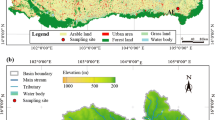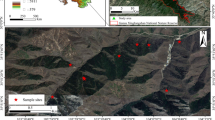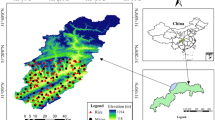Abstract
Purpose
Soil nutrients, elemental stoichiometry, and their associated environmental control play important roles in nutrient cycling. The objectives of this study were (1) to investigate soil nutrients and elemental stoichiometry, especially potassium and its associative elemental stoichiometry with other nutrients under different land uses in terrestrial ecosystems; (2) to discuss the impacts of climate factors, soil texture, and soil physicochemical properties; and (3) to identify the key factors on soil nutrient levels and elemental stoichiometry.
Materials and methods
Soil data, including pH, bulk density (BD), cation exchange capacity (CEC), volumetric water content (VMC), clay, silt and sand contents, total carbon (TC), nitrogen (TN), phosphorous (TP) and potassium (TK), available nitrogen (AN), phosphorus (AP), potassium (AK), and soil organic matter (SOM) under different land-use types, were collected, and their elemental stoichiometry ratios were calculated. Climate data including temperature, precipitation, relative humidity, wind speed, and evapotranspiration were collected. The least significant difference test and one-way analysis of variance were applied to investigate the variability of soil nutrients and elemental stoichiometry among land-use types; the ordinary least squares method and the general linear model were used to illustrate the correlations between soil nutrients, elemental stoichiometry, and soil properties or climate factors and to identify the key influencing factors.
Results and discussion
Woodlands had the highest SOM, TN, AN, and AK contents, followed by grasslands, croplands, and shrublands, while the TP and TK contents only varied slightly among land-use types. SOM, TN, AN, N/P, and N/K were strongly negatively correlated to soil pH (p < 0.05) and were strongly positively correlated to soil CEC (p < 0.05). For soil texture, only C/N was moderately negatively correlated to silt content but moderately positively correlated to sand content (p < 0.05). For climate factors, SOM, TN, AN, N/P, and N/K were significantly negatively correlated to evapotranspiration and temperature (p < 0.05), and the correlations were usually moderate. Soil pH explained most of the total variation in soil nutrients, and climate factors explained 5.64–28.16% of soil nutrients and elemental stoichiometry (except for AP (0.0%) and TK (68.35%)).
Conclusions
The results suggest that climate factors and soil properties both affect soil nutrients and elemental stoichiometry, and soil properties generally contribute more than climate factors to soil nutrient levels. The findings will help to improve our knowledge of nutrient flux responses to climate change while also assisting in developing management measures related to soil nutrients under conditions of climate change.








Similar content being viewed by others
References
Allison SD, Treseder KK (2008) Warming and drying suppress microbial activity and carbon cycling in boreal forest soils. Glob Chang Biol 14:2898–2909
Augusto L, Achat DL, Jonard M, Vidal D, Ringeval B (2017) Soil parent material—a major driver of plant nutrient limitations in terrestrial ecosystems. Glob Chang Biol 23:3808–3824
Bai J, Wang J, Yan D, Gao H, Xiao R, Shao H et al (2012) Spatial and temporal distributions of soil organic carbon and total nitrogen in two marsh wetlands with different flooding frequencies of the Yellow River Delta, China. Clean–Soil Air Water 40:1137–1144
Bing H, Wu Y, Zhou J, Sun H, Luo J, Wang J et al (2016) Stoichiometric variation of carbon, nitrogen, and phosphorus in soils and its implication for nutrient limitation in alpine ecosystem of eastern Tibetan plateau. J Soils Sediments 16:405–416
Blanco-Moure N, Moret-Fernández D, López MV (2012) Dynamics of aggregate destabilization by water in soils under long-term conservation tillage in semiarid Spain. Catena 99:34–41
Cao Y, Chen Y (2017) Ecosystem C: N: P stoichiometry and carbon storage in plantations and a secondary forest on the loess plateau, China. Ecol Eng 105:125–132
Chen LY, Li P, Yang YH (2016) Dynamic patterns of nitrogen: phosphorus ratios in forest soils of China under changing environment. J Geophys Res-Biogeo 121:2410–2421
Cleveland CC, Liptzin D (2007) C: N: P stoichiometry in soil: is there a “Redfield ratio” for the microbial biomass? Biogeochemistry 85:235–252
Craine JM, Dybzinski R (2013) Mechanisms of plant competition for nutrients, water and light. Funct Ecol 27:833–840
Delgado-Baquerizo M, Maestre FT, Gallardo A, Bowker MA, Wallenstein MD, Quero JL, Ochoa V, Gozalo B, García-Gómez M, Soliveres S, García-Palacios P, Berdugo M, Valencia E, Escolar C, Arredondo T, Barraza-Zepeda C, Bran D, Carreira JA, Chaieb M, Conceição AA, Derak M, Eldridge DJ, Escudero A, Espinosa CI, Gaitán J, Gatica MG, Gómez-González S, Guzman E, Gutiérrez JR, Florentino A, Hepper E, Hernández RM, Huber-Sannwald E, Jankju M, Liu J, Mau RL, Miriti M, Monerris J, Naseri K, Noumi Z, Polo V, Prina A, Pucheta E, Ramírez E, Ramírez-Collantes DA, Romão R, Tighe M, Torres D, Torres-Díaz C, Ungar ED, Val J, Wamiti W, Wang D, Zaady E (2013) Decoupling of soil nutrient cycles as a function of aridity in global drylands. Nature 502:672–676
Delgado-Baquerizo M, Reich PB, Khachane AN, Campbell CD, Thomas N, Freitag TE, Abu al-Soud W, Sørensen S, Bardgett RD, Singh BK (2017) It is elemental: soil nutrient stoichiometry drives bacterial diversity. Environ Microbiol 19:1176–1188
Dijkstra FA, Pendall E, Morgan JA, Blumenthal DM, Carrillo Y, LeCain DR et al (2012) Climate change alters stoichiometry of phosphorus and nitrogen in a semiarid grassland. New Phytol 196:807–815
Feng D, Bao W, Pang X (2017a) Consistent profile pattern and spatial variation of soil C/N/P stoichiometric ratios in the subalpine forests. J Soils Sediments 17:2054–2065
Feng J, Zhou J, Wang L, Cui X, Ning C, Wu H et al (2017b) Effects of short-term invasion of Spartina alterniflora and the subsequent restoration of native mangroves on the soil organic carbon, nitrogen and phosphorus stock. Chemosphere 184:774–783
Gao Y, He N, Yu G, Chen W, Wang Q (2014) Long-term effects of different land use types on C, N, and P stoichiometry and storage in subtropical ecosystems: a case study in China. Ecol Eng 67:171–181
Homann PS, Kapchinske JS, Boyce A (2007) Relations of mineral-soil C and N to climate and texture: regional differences within the conterminous USA. Biogeochemistry 85:303–316
Jun M, Altor AE, Craft CB (2013) Effects of increased salinity and inundation on inorganic nitrogen exchange and phosphorus sorption by tidal freshwater floodplain forest soils, Georgia (USA). Estuar Coasts 36:508–518
Lawniczak A, Güsewell S, Verhoeven J (2009) Effect of N: K supply ratios on the performance of three grass species from herbaceous wetlands. Basic Appl Ecol 10:715–725
Li Y, Wu J, Liu S, Shen J, Huang D, Su Y et al (2012) Is the C: N: P stoichiometry in soil and soil microbial biomass related to the landscape and land use in southern subtropical China? Glob Biogeochem Cycles 26:GB4002
Li C, Zhao L, Sun P, Zhao F, Kang D, Yang G et al (2016) Deep soil C, N, and P stocks and stoichiometry in response to land use patterns in the loess hilly region of China. PLoS One 11:e0159075
Liu X, Ma J, Ma ZW, Li LH (2017a) Soil nutrient contents and stoichiometry as affected by land-use in an agro-pastoral region of Northwest China. Catena 150:146–153
Liu Y, Jiang M, Lu X, Lou Y, Liu B (2017b) Carbon, nitrogen and phosphorus contents of wetland soils in relation to environment factors in Northeast China. Wetlands 37:153–161
Loomis MJ, Craft CB (2010) Carbon sequestration and nutrient (nitrogen, phosphorus) accumulation in river-dominated tidal marshes, Georgia, USA. Soil Sci Soc Am J 74:1028–1036
Lu Q, Bai J, Zhang G, Zhao Q, Wu J (2018) Spatial and seasonal distribution of carbon, nitrogen, phosphorus, and sulfur and their ecological stoichiometry in wetland soils along a water and salt gradient in the Yellow River Delta, China. Phys Chem Earth 104:9–17
Marty C, Houle D, Gagnon C, Courchesne F (2017) The relationships of soil total nitrogen concentrations, pools and C: N ratios with climate, vegetation types and nitrate deposition in temperate and boreal forests of eastern Canada. Catena 152:163–172
McLauchlan K (2006) The nature and longevity of agricultural impacts on soil carbon and nutrients: a review. Ecosystems 9:1364–1382
Mooshammer M, Hofhansl F, Frank AH, Wanek W, Hämmerle I, Leitner S et al (2017) Decoupling of microbial carbon, nitrogen, and phosphorus cycling in response to extreme temperature events. Sci Adv 3:e1602781
Oleksyn J, Reich P, Zytkowiak R, Karolewski P, Tjoelker M (2003) Nutrient conservation increases with latitude of origin in European Pinus sylvestris populations. Oecologia 136:220–235
Parfitt R, Giltrap D, Whitton J (1995) Contribution of organic matter and clay minerals to the cation exchange capacity of soils. Commun Soil Sci Plan 26:1343–1355
Penuelas J, Poulter B, Sardans J, Ciais P, Van Der Velde M, Bopp L et al (2013) Human-induced nitrogen–phosphorus imbalances alter natural and managed ecosystems across the globe. Nat Commun 4:2934
Pribyl DW (2010) A critical review of the conventional SOC to SOM conversion factor. Geoderma 156:75–83
Redfield AC (1958) The biological control of chemical factors in the environment. Am Sci 46:205–221
Rivas-Ubach A, Sardans J, Pérez-Trujillo M, Estiarte M, Peñuelas J (2012) Strong relationship between elemental stoichiometry and metabolome in plants. Proc Natl Acad Sci U S A 109:4181–4186
Sardans J, Peñuelas J (2014) Climate and taxonomy underlie different elemental concentrations and stoichiometries of forest species: the optimum “biogeochemical niche”. Plant Ecol 215:441–455
Sardans J, Peñuelas J (2015) Potassium: a neglected nutrient in global change. Glob Ecol Biogeogr 24:261–275
Sardans J, Peñuelas J, Coll M, Vayreda J, Rivas-Ubach A (2012a) Stoichiometry of potassium is largely determined by water availability and growth in Catalonian forests. Funct Ecol 26:1077–1089
Sardans J, Rivas-Ubach A, Penuelas J (2012b) The elemental stoichiometry of aquatic and terrestrial ecosystems and its relationships with organismic lifestyle and ecosystem structure and function: a review and perspectives. Biogeochemistry 111:1–39
Sardans J, Rivas-Ubach A, Peñuelas J (2012c) The C: N: P stoichiometry of organisms and ecosystems in a changing world: a review and perspectives. Perspect Plant Ecol 14:33–47
Serrano O, Lavery PS, Duarte CM, Kendrick GA, Calafat A, York PH et al (2016) Can mud (silt and clay) concentration be used to predict soil organic carbon content within seagrass ecosystems? Biogeosciences 13(17):4915–4926
Shangguan W, Dai Y, Liu B, Ye A, Yuan H (2012) A soil particle-size distribution dataset for regional land and climate modelling in China. Geoderma 171:85–91
Shangguan W, Dai Y, Liu B, Zhu A, Duan Q, Wu L et al (2013) A China data set of soil properties for land surface modeling. J Adv Model Earth Syst 5:212–224
Tang F, Huang T, Fan R, Luo D, Yang H, Huang CC (2019) Temporal variation in sediment C, N, and P stoichiometry in a plateau lake during sediment burial. J Soils Sediments 1–13. https://doi.org/10.1007/s11368-019-02501-5
Tian H, Chen G, Zhang C, Melillo JM, Hall CA (2010) Pattern and variation of C: N: P ratios in China’s soils: a synthesis of observational data. Biogeochemistry 98:139–151
Tian L, Zhao L, Wu X, Fang H, Zhao Y, Yue G et al (2017) Vertical patterns and controls of soil nutrients in alpine grassland: implications for nutrient uptake. Sci Total Environ 607:855–864
Tian L, Zhao L, Wu X, Fang H, Zhao Y, Hu G et al (2018) Soil moisture and texture primarily control the soil nutrient stoichiometry across the Tibetan grassland. Sci Total Environ 622:192–202
Tian L, Zhao L, Wu X, Hu G, Fang H, Zhao Y et al (2019) Variations in soil nutrient availability across Tibetan grassland from the 1980s to 2010s. Geoderma 338:197–205
Wang G, Zhang J (2015) Variation of water resources in the Huang-huai-hai areas and adaptive strategies to climate change. Quat Int 380:180–186
Wang HM, Wang WJ, Chen HF, Zhang ZH, Mao ZJ, Zu YG (2014a) Temporal changes of soil physic- chemical properties at different soil depths during larch afforestation by multivariate analysis of covariance. Ecol Evol 4(7):1039–1048
Wang W, Sardans J, Zeng C, Zhong C, Li Y, Peñuelas J (2014b) Responses of soil nutrient concentrations and stoichiometry to different human land uses in a subtropical tidal wetland. Geoderma 232:459–470
Wang X, Ma X, Yan Y (2017) Effects of soil C: N: P stoichiometry on biomass allocation in the alpine and arid steppe systems. Ecol Evol 7:1354–1362
Wang XM, Lang LL, Hua T, Li H, Zhang CX, Ma WY (2018) Effects of aeolian processes on soil nutrient loss in the Gonghe Basin, Qinghai-Tibet plateau: an experimental study. J Soils Sediments 18(1):229–238
Whitehead DC (2000) Nutrient elements in grassland: soil-plant-animal relationships. CABI International, London
Withers P, Hodgkinson R (2009) The effect of farming practices on phosphorus transfer to a headwater stream in England. Agric Ecosyst Environ 131:347–355
Wu XD, Zhao L, Fang HB, Zhao YG, Smoak JM, Pang QQ, Ding YJ (2016) Environmental controls on soil organic carbon and nitrogen stocks in the high-altitude arid western Qinghai-Tibetan plateau permafrost region. J Geophys Res-Biogeo 121(1):176–187
Wu X, Fang H, Zhao Y, Smoak JM, Li W, Shi W et al (2017) A conceptual model of the controlling factors of soil organic carbon and nitrogen densities in a permafrost-affected region on the eastern Qinghai-Tibetan plateau. J Geophys Res-Biogeo 122:1705–1717
Xiao R, Bai J, Gao H, Huang L, Deng W (2012) Spatial distribution of phosphorus in marsh soils of a typical land/inland water ecotone along a hydrological gradient. Catena 98:96–103
Xu Y, Gao X, Shen Y, Xu C, Shi Y, Giorgi A (2009) A daily temperature dataset over China and its application in validating a RCM simulation. Adv Atmos Sci 26:763–772
Xu X, Thornton PE, Post WM (2013) A global analysis of soil microbial biomass carbon, nitrogen and phosphorus in terrestrial ecosystems. Glob Ecol Biogeogr 22:737–749
Yan D, Xu T, Girma A, Yuan Z, Weng B, Qin T et al (2017) Regional correlation between precipitation and vegetation in the Huang-Huai-Hai River basin, China. Water 9:w9080557
Yang Y, Fang J, Tang Y, Ji C, Zheng C, He J et al (2008) Storage, patterns and controls of soil organic carbon in the Tibetan grasslands. Glob Chang Biol 14:1592–1599
Yao Z, Zheng X, Xie B, Mei B, Wang R, Butterbach-Bahl K et al (2009) Tillage and crop residue management significantly affects N-trace gas emissions during the non-rice season of a subtropical rice-wheat rotation. Soil Biol Biochem 41:2131–2140
Yavitt JB, Wright SJ, Wieder RK (2004) Seasonal drought and dry-season irrigation influence leaf-litter nutrients and soil enzymes in a moist, lowland forest in Panama. Austral Ecol 29:177–188
Yin YL, Ying H, Zheng HF, Zhang QS, Xue YF, Cui ZL (2019) Estimation of NPK requirements for rice production in diverse Chinese environments under optimal fertilization rates. Agric For Meteorol. https://doi.org/10.1016/j.agrformet.2019.107756
Yu Z, Wang M, Huang Z, Lin TC, Vadeboncoeur MA, Searle EB et al (2018) Temporal changes in soil C-N-P stoichiometry over the past 60 years across subtropical China. Glob Chang Biol 24:1308–1320
Yue K, Fornara DA, Yang W, Peng Y, Li Z, Wu F et al (2017) Effects of three global change drivers on terrestrial C: N: P stoichiometry: a global synthesis. Glob Chang Biol 23:2450–2463
Zhang D, Zhang J, Yang W, Wu F, Huang Y (2014) Plant and soil seed bank diversity across a range of ages of Eucalyptus grandis plantations afforested on arable lands. Plant Soil 376:307–325
Zhang Z, Xue Z, Lyu X, Tong S, Jiang M (2017) Scaling of soil carbon, nitrogen, phosphorus and C: N: P ratio patterns in peatlands of China. Chin Geogr Sci 27:507–515
Zheng H, Yu GR, Wang QF, Zhu XJ, He HL, Wang YF et al (2016) Spatial variation in annual actual evapotranspiration of terrestrial ecosystems in China: results from eddy covariance measurements. J Geogr Sci 36(10):1391–1411
Zhou Y, Boutton TW, Wu XB (2018) Soil phosphorus does not keep pace with soil carbon and nitrogen accumulation following woody encroachment. Glob Chang Biol 24:1992–2007
Zhu Z, Chen D (2002) Nitrogen fertilizer use in China–contributions to food production, impacts on the environment and best management strategies. Nutr Cycl Agroecosyst 63:117–127
Funding
This work was supported by the National Key Research and Development Program of China (grant number 2017YFA0605003).
Author information
Authors and Affiliations
Corresponding author
Additional information
Responsible editor: Chengrong Chen
Publisher’s note
Springer Nature remains neutral with regard to jurisdictional claims in published maps and institutional affiliations.
Rights and permissions
About this article
Cite this article
Li, Y., Ma, J., Xiao, C. et al. Effects of climate factors and soil properties on soil nutrients and elemental stoichiometry across the Huang–Huai–Hai River Basin, China. J Soils Sediments 20, 1970–1982 (2020). https://doi.org/10.1007/s11368-020-02583-6
Received:
Accepted:
Published:
Issue Date:
DOI: https://doi.org/10.1007/s11368-020-02583-6




